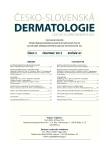Hypoallergenic Diet Influence on the Inflammation Intensity, Itching and Sleeplessness in Atopic Patients
Authors:
J. Čelakovská 1; K. Ettlerová 2; K. Ettler 1; J. Vaněčková 1; J. Bukač 3
Authors‘ workplace:
Klinika nemocí kožních a pohlavních FN a LF UK Hradec Králové
přednosta doc. MUDr. Karel Ettler, CSc.
1; Ambulance klinické imunologie a alergologie, Hradec Králové
vedoucí MUDr. Květuše Ettlerová
2; Ústav lékařské biofyziky LF UK Hradec Králové, přednosta doc. Ing. Josef Hanuš, CSc.
3
Published in:
Čes-slov Derm, 87, 2012, No. 3, p. 93-97
Category:
Pharmacologyand Therapy, Clinical Trials
Overview
Aim:
To evaluate the possible influence of the diagnostic hypoallergenic diet on disease intensity and subjective parameters in patients suffering from atopic dermatitis.
Methods:
The diagnostic hypoallergenic diet for the period of 3 weeks was recommended to patients with atopic eczema. Severity of eczema was scored according to the SCORAD score and intensity criteria (erythema, oedema, crusting, excoriations, lichenification, dryness) and subjective parameters (pruritus, sleeplessness) were evaluated at the beginning and at the end of the diet.
Results:
149 patients, including 108 women and 41 men, with the average age of 26.03 (s. d. 9.6 years), range from 14 to 63 years, completed the diet. There was a statistically significant reduction in the severity of sleeplessness and pruritus and a reduction in all of the intensity criteria except for lichenification at the end of this diet.
Conclusion:
The diagnostic hypoallergenic diet can improve the intensity and subjective parameters of atopic dermatitis evaluated by SCORAD index except for lichenification. We recommend to introduce the diet as a temporary medical tool in patients suffering from moderate or severe atopic dermatitis and as well as a diagnostic tool in the diagnosis of food allergy.
Key words:
atopic dermatitis – diagnostic hypoallergenic diet – SCORAD index – sleeplessness – pruritus – intensity of atopic dermatitis
Sources
1. BATH-HEXTALL, F., DELAMERE, F. M., WILLIAMS, H. C. Dietary exclusions for establihed atopic eczema. Cochrane Database Syst. Rev., 2008, 23, 1, CD005203.
2. BREUER, K., WULF, A., CONSTIEN, A., TETAU, D., KAPP, A., WERFEL, T. Birch pollen-related food as a provocation factor of allergic symptoms in children with atopic eczema/dermatitis syndrome. Allergy, 2004, 59, p. 988–994.
3. ČELAKOVSKÁ J., ETTLEROVÁ K., ETTLER K., VANĚČKOVÁ J., BUKAČ J. Význam diagnostické hypoalergenní diety u pacientů s atopickým ekzémem. Čes-slov Derm., 2011, 86, 3, s. 138–143.
4. ČELAKOVSKÁ J., ETTLEROVÁ K., ETTLER K., VANĚČKOVÁ J., BUKAČ J. Význam atopických epikutánních testů a dalších vyšetřovacích metod v diagnostice potravinové alergie na arašídy u pacientů s atopickým ekzémem starších 14 let. Význam pylové alergie u této skupiny pacientů. Čes-slov Derm., 2009, 84, 6, s. 332 až 340.
5. ČELAKOVSKÁ J., ETTLEROVÁ K., ETTLER K., VANĚČKOVÁ J., BUKAČ J. Význam potravinové alergie na sóju u pacientů s atopickým ekzémem starších 14 let. Čs. derm., 2010, 85, 1, s. 14–20.
6. ČELAKOVSKÁ J., ETTLEROVÁ K., ETTLER K., VANĚČKOVÁ J., BUKAČ J. Význam atopických epikutánních testů a dalších vyšetřovacích metod v diagnostice potravinové alergie na kravské mléko a pšeničnou mouku u pacientů s atopickým ekzémem ve věku nad 14 let. Čs. derm., 2009, 84, 5, s. 254–263.
7. ČELAKOVSKÁ J., ETTLEROVÁ K., ETTLER K., VANĚČKOVÁ J. Egg allergy in patients over 14 years old suffering from atopic eczema. Int. J. Dermatol., 2011, 50, p. 811–818.
8. ETTLER, K. Indexy v klinickém hodnocení psoriázy a atopického ekzému. Čes-slov Derm., 1995, 70, 1, s. 45–47.
9. ETTLEROVÁ, K. Diagnostika potravinové alergie u nemocných s atopickým ekzémem. Dermatologie pro praxi, 2008, 2, s. 88–91.
10. FUCHS, M. Potravinová alergie. Practicus, 2008, 6, s. 30–34.
11. FUCHS, M. Mouka – imunologické reakce přecitlivělosti. Alergie, 2005, 3, s. 222–229.
12. GREWE, M., BRUINZEEL-KOOMEN, C., SCHOPF, E. et al. A role for Th1 and Th2 cells in the immunopathogenesis of atopic dermatitis. Immunol. Today, 1998, 19, p. 359–361.
13. HAMID, Q., BOGUNIEWICZ, M., LEUNG, D. Differential in situ cytokine gene expression in acute versus chronic atopic dermatitis. J. Clin. Invest., 1994, 94, p. 870–876.
14. HOST, A. Cows milk protein allergy and intolerance in infancy. Pediatr. Allergy Immunol., 1994, 5, p. 5–36.
15. NEČAS, M., DASTYCHOVÁ, E. Srovnání výsledků atopických epikutánních testů s ostatními metodami identifikace aeroalergenů jako spouštěčů atopického ekzému. Čes-slov Derm., 2007, s. 209.
16. RONA, R. J., KEIL, T., SUMMERS, C., GISLASON, D., ZUIDMEER, L., SODERGREN, E., SIGURDARDOTTIR, S. T., LINDNER, T., GOLDHAHN, K., DAHLSTROM, J., MCBRIDE, D., MADSEN, C. The prevalence of food allergy: A meta-analysis. J. Allergy Clin. Immunol., 2007, 120, 3, p. 638–646.
17. SOUMELIS, V., RECHE, P., KANZLER, H. et al. Human epithelial cells trigger dendritic cell mediated allergic inflammation by producing TSLP. Nat. Immunol., 2002, 3, s. 673–680.
18. WERFEL, T., BALLMER-WEBER, B., EIGENMANN, P. A., NIGGEMANN, B., RANCÉ, F., TURJANMAA, K., WORM, M. Eczematous reactions to food in atopic eczema: position paper of the EAACI and GA2LEN. Allergy, 2007, 62, p. 723–728.
Labels
Dermatology & STDs Paediatric dermatology & STDsArticle was published in
Czech-Slovak Dermatology

2012 Issue 3
Most read in this issue
- The Most Common Primary Cicatricial Alopecias
- Sweet’s Syndrome
- Calciphylaxis with Skin Ulcers. Case Report
- Hypoallergenic Diet Influence on the Inflammation Intensity, Itching and Sleeplessness in Atopic Patients
